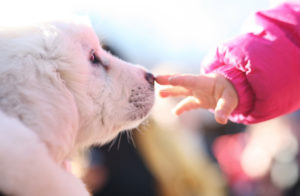
In her book, Animals Make Us Human, Temple Grandin asks the question: What does an animal need to be happy?
Grandin lists five freedoms animals should have when in an intensive animal production situation:
- Freedom from hunger and thirst
- Freedom from discomfort
- Freedom from pain, injury or disease
- Freedom to express normal behavior
- Freedom from fear and distress
Grandin says that to create optimum situations for animals we have to start with the animals’ emotions.
If we get the emotions right, we’ll have fewer problem behaviors.
Citing Dr. Jaak Panksepp’s work, Grandin describes seven “blue ribbon emotions” that animals have: SEEKING, RAGE, FEAR, PANIC, LUST, CARE and PLAY. When referring to these emotions the words are in all capitals to help with specific meaning.
SEEKING is “the basic impulse to search, investigate, and make sense of the environment.”
RAGE gives a captured animal the huge burst of energy necessary to get a predator to loosen its grip and be able to then run away. Frustration is a mild form of RAGE. When an animal feels trapped, RAGE takes over.
FEAR is an emotion that probably doesn’t need a lot of explanation, but is in response to not feeling safe and feeling that one’s survival is threatened.
PANIC refers to the social attachment system. When babies are separated from their mothers, this system kicks in and we hear distinctive separation cries from the babies.
LUST refers to sex and sexual desire.
CARE is about maternal caretaking and love.
PLAY system produces feelings of joy and is associated with the spontaneous activity of the animal.
With her research and work with pigs Grandin saw that environmental deprivation created hyperactive pigs and that when the SEEKING system was not satisfied abnormal brain development occurred in the pigs.
What makes an environment stimulating?
Grandin tells us, “The only guide people have to judge whether an environment is good for an animal is the animal’s behavior, which gives us insight into its emotion.”
These insights into animal behavior may help us illuminate some of the essential elements of our human behavior, both child and adult.
When we experience physical or mental distress, certain core emotions are involved that create problem behaviors. We have to observe behavior and think about the emotion that is driving it, and the need behind the emotion.
Phrases used to convey a deep emotional understanding and experience with animals are not in most of our experiences. “Madder than a wet hen”. How many wet hens do we see nowadays? But once you’ve seen one, the expression takes on a distinct meaning, and a deep understanding of a core emotion.
The stories Grandin shares about these seven core emotions involving pigs, cats, dogs, horses, chickens and wildlife, give us insight into how animals make us human. Living around animals and observing their behaviors provides insight into our emotions in a profound way, and is at risk of being lost.
Learn more about core emotions to better understand your dog, your children and yourself.

3 Responses to “Understanding Core Emotions”